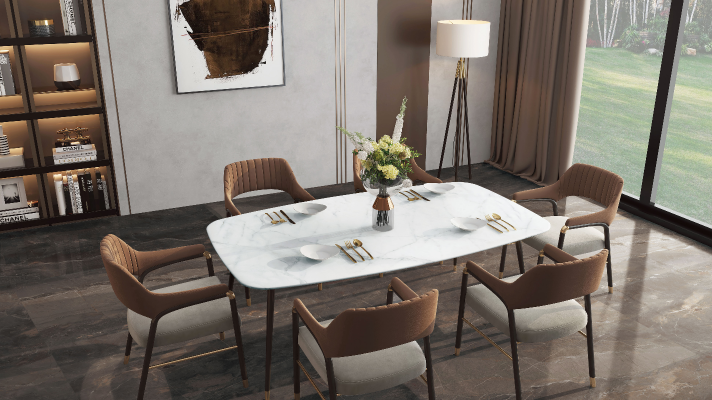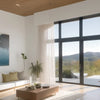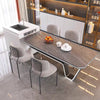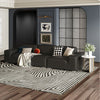What is sintered stone and the guide of Sintered stone (Updated 2023)

In the count top of furniture, there are many choices, such as ceramics, and marble. Sintered stone is undoubtedly the most durable, easy-to-clean, and versatile material. Sintered stone is made by firing various pure natural raw materials, such as clay and stone, and pressing them with ultra-high pressure. In the selection of raw materials, raw materials with high aluminum and high potassium will be hand-picked to achieve better performance.
What and how is sintered stone made?

There are eight steps of process a sintered stone top - Feeding、pressing—Drying--Inkjet printing、glazing, etc-- Firing--Polish. The processing of sintered stone is similar to the natural granite formation process, but we only need a few hours instead of thousands of years. There are strict requirements on the selection and use of raw materials, not only the use of inorganic raw materials of Dphome sintered stone countertops, but also the sintered stone produced in this way has high hardness, better flatness and compactness, and is not easy to seep. Because good materials have a high degree of oxidation during the production process, the finished green body fired in this way has high whiteness and no black spots. The raw materials that pass the entry inspection will enter the next stage for weighing and transportation. The accuracy of the proportioning and dosage of raw materials is very high, reaching ±0.03%.
Where and what is sintered stone used for?
Sintered stone surface can be used on the surface of most furniture, such as:
- Table surface
- kitchen worktops
- Bathroom vanities and countertops
- Wall Covering
- Fireplace surround and so on.
For the application scenario of rock slabs, size is the main limiting factor. If it is a particularly large wall, multiple rock slabs may need to be cut and spliced. However, you can choose DPhome's whole house sintered stone customization service. DPhome has professional designers and construction teams, and has a large factory in China. There are many sizes and colors to choose from, which can meet most of different decoration styles. The full-body slate means that the slate has a very high consistency and is easy to match.
What are the advantages of Sintered stone?
There are seven advantages of sintered stone, omnipotent application, food safety, anti-pollution, easy to clean, flexible customization, scratch resistant, and corrosion resistance.
Omnipotent application:
Due to the stable physical and chemical properties of sintered stone, it can be used in indoor or outdoor scenes, such as swimming pools or outdoor walls, and kitchen countertops.
FOOD SAFETY:
Can be in direct contact with food. Pure natural selection of materials.100% recyclable, non-toxic and non-radioactive, formaldehyde free, health, and environmental protection.
ANTI-POLLUTION:
The 1/10,000 water penetration rate of sintered stone is a new indicator in the world of artificial building materials, Where stains cannot penetrate and at bacterial cannot grow.
EASY TO CLEAN:
It only needs to be wiped with a damp towel to clean up, no special maintenance requirements, and the cleaning is simple and fast.
FLEXIBLE CUSTOMIZATION:
The texture of sintered stone is rich and varied, which can be customized according to the user's needs.
HIGH TEMPERATURE:
Direct contact with high-temperature objects will not deform, and the A1-level fire -resistant slate will not produce any physical changes (shrinkage, cracking, discoloration) when encountering an open flame of 2000 ° C, nor will it emit any gas or odor.
SCRATCH RESISTANT:
With a Mohs hardness of 5, most of the utensils in daily life cannot leave scratches.
CORROSION RESISTANCE:
Resistant to various chemicals, including solutions, disinfectants, etc.
If you are looking for more details about sintered stone furniture, dining table, or coffee table, please subscribe us for the newest information. Also we allowed Whole house Sintered stone customization.
FAQs:
-
What is sintered stone and how is it made? Sintered stone is a durable, easy-to-clean, and versatile material made by firing various pure natural raw materials like clay and stone, and pressing them with ultra-high pressure. The process involves feeding, pressing, drying, inkjet printing, glazing, firing, and polishing. The selection of raw materials involves high-quality materials with high aluminum and high potassium for better performance.
-
What are the applications of sintered stone? Sintered stone can be used on the surface of most furniture. It's suitable for table surfaces, kitchen worktops, bathroom vanities, countertops, wall coverings, and fireplace surrounds. However, for large walls, multiple sintered stone slabs may need to be cut and spliced.
-
What are the benefits of using sintered stone? The advantages of sintered stone include its broad application, food safety, anti-pollution features, ease of cleaning, flexible customization, scratch resistance, and corrosion resistance. It can also be in direct contact with high-temperature objects without deformation.
-
What is the process of making sintered stone at DPhome? At DPhome, sintered stone is created using a strict process that requires the use of high-quality raw materials. The process involves eight steps: feeding, pressing, drying, inkjet printing, glazing, firing, and polishing. The proportioning and dosage of raw materials are highly accurate, reaching ±0.03%.
-
Does DPhome offer customization services for sintered stone? Yes, DPhome offers whole house sintered stone customization services. They have professional designers, construction teams, and a large factory in China, with many sizes and colors available to meet different decoration styles.
-
Posted in
sintered stone





